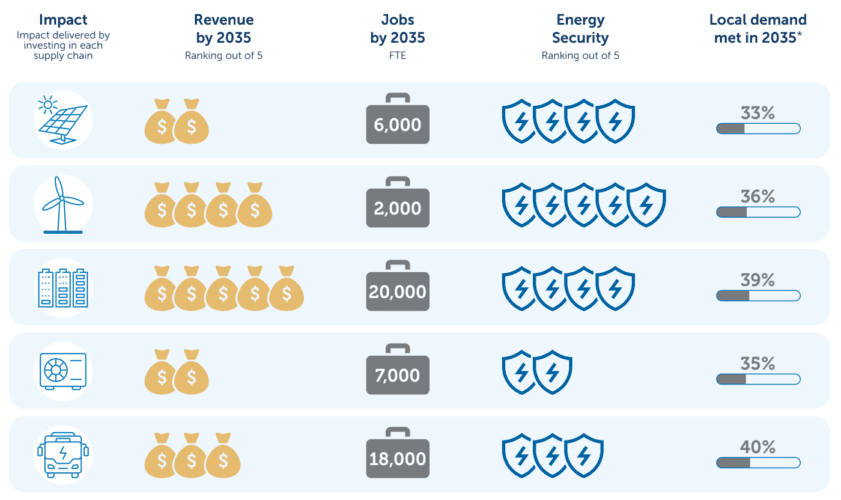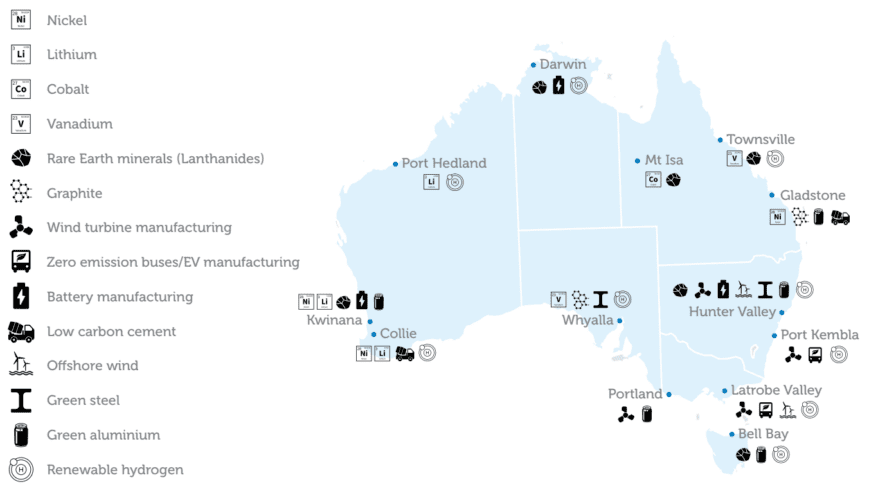From solar to EVs: Five green tech supply chains that could deliver $215 billion boost to Australia
Building Australian supply chains for the manufacture of solar, wind, batteries, heat pumps and commercial electric vehicles could deliver $215 billion of benefits in just a decade, a new report has found, provided we get the policy and regulatory settings right.
The Make It Here report by the think tank Beyond Zero Emissions (BZE) estimates this is the sort of economic return Australia could get from its own raw minerals reserves if can move beyond the current dig and ship model and start processing, manufacturing and recycling onshore.
Calls to value-add to Australia’s mineral resources have been around since before Donald Horne published The Lucky Country in 1964.
To make it work, says BZE CEO Heidi Lee, would require structured financial support, the development of cleantech manufacturing hubs, recycling for new energy devices, and ensuring demand for locally-made cleantech.
“We do have to grow a lot more than what we have been in our manufacturing sector,” Lee tells RenewEconomy.
“There’s some statistics on how much manufacturing grows already and it’s in the single digit billions. This report is talking about growth in a single year of an additional $20 billion until 2035. We are now looking at how we back in our industries to achieve that.
“We need to build capability at the top and tail of cleantech supply chains so we are better equipped to capture the benefits from our consumer products right through to waste that we currently have to bury or ship overseas.”
Niche industries could include battery manufacturing: the avoided shipping cost of transporting these heavy devices could defray the cost fears of making them at home.
Already Energy Renaissance is operating the country’s first lithium-ion gigafactory in the Hunter Valley, NSW, while in Geelong Li-S Energy is also planning its own 10 GWh battery factory.
In the case of heat pumps, solar panels or wind turbine parts, the conversation must start with recycling as the world falls short of produced minerals to meet emissions targets. The amount of waste from end-of-life equipment means recycling is a major opportunity – which can then feed into a level of local manufacturing.
Getting the ball moving with cash and content
BZE says financial support should be in the form of production credits which tail off over time, bridging the gap between local and lower-cost overseas manufacturing as well as giving certainty to investors.
The federal government has already unveiled its $1 billion Solar Sunshot program which is broadly seen as a key first step to put Australia back into the cleantech manufacturing race.
Internationally, the US’s Inflation Reduction Act (IRA) and the European Green Deal are major investments in local content manufacturing; Canada has its $A90 billion in tax credits; and in Asia, Korea and Japan have battery and EV subsidies, Indonesia is banning exports of its high quality nickel to onshore batteries industries, and India is offering incentives to develop a solar industry.
But investment means nothing if there is no market for locally made goods.
Demand should be assured via local content requirements, Lee says; a move the Australian government is considering for the upcoming offshore wind sector but has not previously committed to for onshore cleantech industries.
The BZE report says local content requirements would backstop a 5 gigawatt (GW) solar industry ($14 billion and 6,000 jobs by 2035) and the equivalent of five gigafactories for batteries ($114 billion and 20,000 jobs).
The wind industry should have a 36 per cent local content requirement ($35 billion and 2,000 jobs), it suggests.
The report doesn’t state what level of local content commercial EVs and heat pumps should involve, but puts these industries at an estimated value of $37 billion and 18,000 jobs, and $17 billion and 7,000 jobs, respectively.

Modern slavery and ethics laws are also creating a domestic procurement opportunity as a way to avoid unethical goods and sell into markets with strong anti-slavery laws.
There is evidence of widespread child labour in cobalt mines in the Democratic Republic of Congo, which produced up to 74 per cent of the world’s cobalt supply in 2021.
In the solar market, 35 per cent of the global supply of polysilicon, which is the primary material used to manufacture PV, is sourced from the Xinjiang Uyghur Autonomous Region of China where Uyghur and other Muslim nationals work under questionable labour conditions.
Last week, the European Parliament joined the US in banning the import of products manufactured with forced labour. In the US, 2831 shipments of products, including solar panels, have been stopped at the border in 2024 due to forced labour enforcement action.
“As the country moves to embrace clean energy, the dirty secret of unethical supply chains remains out of sight of the general public,” says Fair Futures CEO Fiona David.
“In light of the federal government’s unveiling of the Future Made in Australia Act, critical examination of the risks of modern slavery in the supply chain is needed if we truly want to achieve clean energy. The risk of forced labour and slavery is high in solar and battery energy supply chains, especially when it comes to the acquisition and processing of source minerals.
Location location location
The report calls for the national coordination of renewable energy industrial hubs, overseen by a new National Clean Industry Infrastructure Authority with a master plan covering infrastructure planning across states and territories.
The largest and most immediate opportunities are in regional clean industrial precincts like those in Townsville, Gladstone, Tamworth and Portland – leveraging the industrial workforce and access to land, existing infrastructure and proximity to renewable energy zones, says Energy Estate cofounder Simon Currie.
“Building competitive local manufacturing capacity will be an immense challenge, but it won’t happen if we don’t try,” Currie says.
“Making most of these opportunities will require the clean industry to be collaborative and open, and for our politicians to work together to deliver the best outcomes for Australia.”

Lee says clustering companies in hubs can avoid 60-75 per cent of costs from transmission line duplication alone, but few companies are coordinating their plans and this is leading to competition for resources.
“A lot of different players in industry hubs are independently pursuing ambitious projects and that’s created a bottleneck around the skills and materials that we need to get any of them across the line,” she says.
“For cleantech manufacturing to happen in these industry hubs, we’re shifting our focus from looking at momentum to [recommending] a national coordinated plan.”
The Kwinana industrial area south of Perth is a prime example of what could be done: it has an existing embedded energy network and pipelines; the challenge now is backfilling those with green hydrogen and renewable energy.
